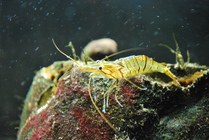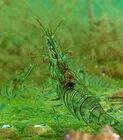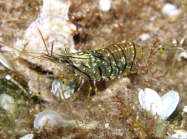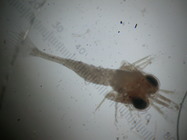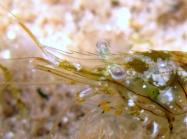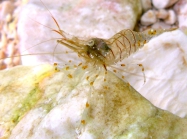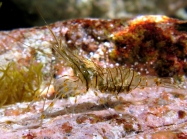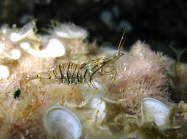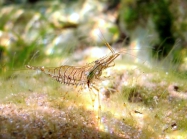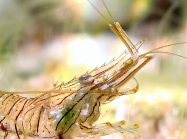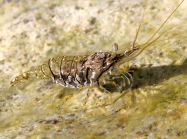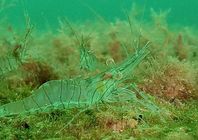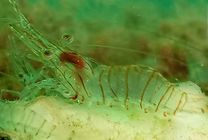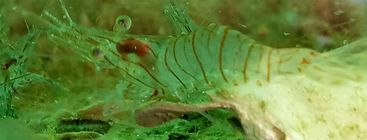
| Intro | | About | | Wiki | | Search traits | | Data explorer | | Literature | | Definitions | | Sources | | Webservices | | Statistics | | Feedback | | Editors | | Log in |
Traits taxon detailsPalaemon elegans Rathke, 1836
107614 (urn:lsid:marinespecies.org:taxname:107614)
accepted
Species
Leander squilla var. intermedia De Man, 1915 · unaccepted > junior subjective synonym
Palaemon minans Norman, 1861 · unaccepted > junior subjective synonym
Palaemonella gracilis Paulson, 1875 · unaccepted > junior subjective synonym
marine, brackish,
recent only
Rathke, H. (1836). Zur Fauna der Krym. [On the Fauna of Crimea]. <em>Mémoires de l'Académie Impériale des Sciences de Saint Pétersbourg.</em> 3(3-4): 291-454, pls. 1-10 [imprint 1837; preprint dated 1836]., available online at http://www.biodiversitylibrary.org/bibliography/11609#/summary [details]
DecaNet eds. (2025). DecaNet. Palaemon elegans Rathke, 1836. Accessed through: Marine Species Traits editorial board (2025) Marine Species Traits at: https://www.marinespecies.org/traits/aphia.php?p=taxdetails&id=107614 on 2025-09-14
Marine Species Traits editorial board (2025). Marine Species Traits. Palaemon elegans Rathke, 1836. Accessed at: https://www.marinespecies.org/traits/aphia.php?p=taxdetails&id=107614 on 2025-09-14
Date action by
original description
Rathke, H. (1836). Zur Fauna der Krym. [On the Fauna of Crimea]. <em>Mémoires de l'Académie Impériale des Sciences de Saint Pétersbourg.</em> 3(3-4): 291-454, pls. 1-10 [imprint 1837; preprint dated 1836]., available online at http://www.biodiversitylibrary.org/bibliography/11609#/summary [details]
original description (of Leander squilla var. intermedia De Man, 1915) De Man, J.G. (1915). On some European species of the genus <i>Leander</i> Desm., also a contribution to the fauna of Dutch waters. <em>Tijdschrift der Nederlandsche Dierkundige Vereeniging, ser. 2.</em> 14: 115-179, pls. 10-12. [details] original description (of Palaemon minans Norman, 1861) Norman, A.M. (1861). Contributions to British Carcinology. I. Characters of undescribed Podophthalmia and Entomostraca. <em>The Annals and Magazine of Natural History, ser. 3.</em> 8: 273-281, pls. 13-14. [details] original description (of Palaemonella gracilis Paulson, 1875) Paulson, O. (1875). Studies on Crustacea of the Red Sea with notes regarding other seas. Part 1 Podophthalmata and Edriophthalmata (Cumacea). [Izsliedovaniia rakoobraznykh Krasnago Moria, s zamietkami otnositelno rakoobraznych drugikh morei. Chast I.: Podophthalmata i Edriophthalmata (Cumacea.)]. <em>Kiev,Tipografiia S.V. Kulzhenko,1875.</em> i-xiv, 1-144, pls. 1-22 [in Russian]., available online at https://biodiversitylibrary.org/page/11097652 [details] context source (Introduced species) Fofonoff, P.W.; Ruiz, G.M.; Steves, B.; Carlton, J.T. (2014-2024). National Exotic Marine and Estuarine Species Information System (NEMESIS). , available online at http://invasions.si.edu/nemesis [details] context source (WoRCS) Bianchi, C. N.; Gerovasileiou, V.; Morri, C.; Froglia, C. (2022). Distribution and Ecology of Decapod Crustaceans in Mediterranean Marine Caves: A Review. <em>Diversity.</em> 14(3): 176., available online at https://www.mdpi.com/1424-2818/14/3/176 [details] Available for editors context source (Schelde) Maris, T., O. Beauchard, S. Van Damme, E. Van den Bergh, S. Wijnhoven & P. Meire. (2013). Referentiematrices en Ecotoopoppervlaktes Annex bij de Evaluatiemethodiek Schelde-estuarium Studie naar “Ecotoopoppervlaktes en intactness index”. [Reference matrices and Ecotope areas Annex to the Evaluation methodology Scheldt estuary Study on “Ecotope areas and intactness index”. <em>Monitor Taskforce Publication Series, 2013-01. NIOZ: Yerseke.</em> 35 pp. (look up in IMIS) [details] context source (BeRMS 2020) Aquatic environment and quality group; Flanders research institute for agriculture, fisheries and food (ILVO), Belgium; (2017): Subtidal epibenthos and demersal fish monitoring in function of a foreshore suppletion at the Belgian coast, period 2013-2016. [details] basis of record Türkay, M. (2001). Decapoda, <B><I>in</I></B>: Costello, M.J. <i>et al.</i> (Ed.) (2001). <i>European register of marine species: a check-list of the marine species in Europe and a bibliography of guides to their identification. Collection Patrimoines Naturels,</i> 50: pp. 284-292 (look up in IMIS) [details] additional source González-Ortegón, E.; Cuesta, J.A. (2006). An illustrated key to species of <i>Palaemon</i> and <i>Palaemonetes</i> (Crustacea: Decapoda: Caridea) from European waters, including the alien species<i> Palaemon macrodactylus</i>. <em>J. Mar. Biol. Ass. U.K.</em> 86(1): 93-102. (look up in IMIS) [details] Available for editors additional source Muller, Y. (2004). Faune et flore du littoral du Nord, du Pas-de-Calais et de la Belgique: inventaire. [Coastal fauna and flora of the Nord, Pas-de-Calais and Belgium: inventory]. <em>Commission Régionale de Biologie Région Nord Pas-de-Calais: France.</em> 307 pp., available online at http://www.vliz.be/imisdocs/publications/145561.pdf [details] additional source De Grave, S.; Fransen, C.H.J.M. (2011). Carideorum catalogus: the recent species of the dendrobranchiate, stenopodidean, procarididean and caridean shrimps (Crustacea: Decapoda). <em>Zoologische Mededelingen, Leiden.</em> 85(9): 195-589. (look up in IMIS) [details] additional source Holthuis, L.B.; Fransen, C.H.J.M. (1993). Coastal Shrimps and Prawns. <em>Coastal Shrimps and Prawns.</em> 15. Second Edition. [details]  Present Present  Inaccurate Inaccurate  Introduced: alien Introduced: alien  Containing type locality Containing type locality
Encyclopedia of Marine Life of Britain and Ireland
Marine Life Information Network - UK To Barcode of Life (77 barcodes) To Biodiversity Heritage Library (2 publications) (from synonym Palaemon minans Norman, 1861) To Biodiversity Heritage Library (27 publications) To Dyntaxa To European Nucleotide Archive, ENA (Palaemon elegans) To Fishipedia To GenBank (299 nucleotides; 290 proteins) To Information system on Aquatic Non-Indigenous and Cryptogenic Species (AquaNIS) To PESI To USNM Invertebrate Zoology Arthropoda Collection (119 records) To ITIS |
